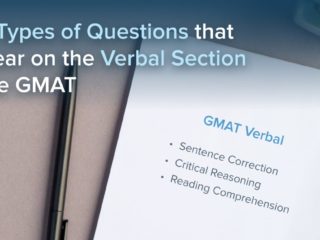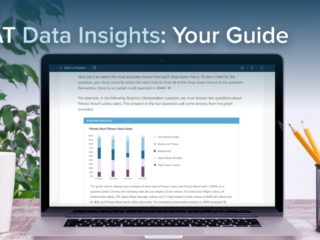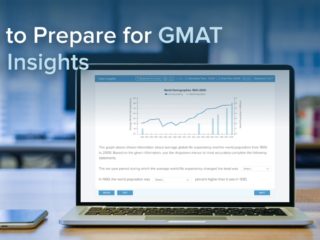| Getting your Trinity Audio player ready... |
Last Updated on October 6, 2023
Of the quant question types on the GMAT, Data sufficiency (DS) questions very well may be the most feared by new GMAT students. Even though you don’t need to calculate a “numerical” answer for a DS question, successfully solving these questions takes a combination of quantitative knowledge, critical thinking, and analytical skills. The good news is that after reading this article, you will see that DS questions do not actually need to be feared.
Now, you may be wondering, what exactly is a Data sufficiency question?
- What Are GMAT Data Sufficiency Questions?
- The Data Sufficiency Answer Choices
- How to Analyze GMAT Data Sufficiency Questions
- Eliminating Data Sufficiency Answer Choices
- Yes/No Data Sufficiency Questions
- Value-Data-Sufficiency-Questions
- Don’t Solve; Determine Sufficiency
What Are GMAT Data Sufficiency Questions?
Data sufficiency questions constitute about one-third of the quant questions on the GMAT. So, of the 31 questions on the GMAT quantitative section, you can expect to see 10-12 DS questions. Thus, when preparing for the GMAT, spending a fair amount of time mastering this question type will be an investment that pays big dividends.
At the most basic level, a data sufficiency question begins with a question stem that contains a question and some optional information followed by two statements (Statement One and Statement Two). Your job is to determine whether you have enough information to answer the question in the stem.
DS questions are one way that the GMAT tests your ability to use logic and decision-making skills in a mathematical setting. A DS question is a blend of math and information processing, a tough combination, especially when you’re taking an intense exam and you’re in a time crunch.
KEY FACT:
DS questions require you to use both your mathematical knowledge and your analytical skills.
If you’re a bit nervous so far, rest assured: With the right approach and a healthy dose of practice, GMAT data sufficiency questions can become not only something you excel at but also a question type that you are happy to see on test day.
Before we explore the various types of data sufficiency questions, let’s start by taking a look at the 5 standard answer choices that are given for every DS question.
GMAT Data Sufficiency Answer Choices
Data sufficiency questions have 5 possible answer choices: A, B, C, D, and E. These answer choices are the same for every DS question, so memorizing them will save you valuable time on the GMAT. The answer choices are as follows:
- Answer A: Statement (1) ALONE is sufficient, but statement (2) alone is not sufficient to answer the question asked.
- Answer B: Statement (2) ALONE is sufficient, but statement (1) alone is not sufficient to answer the question asked.
- Answer C: BOTH statements (1) and (2) TOGETHER are sufficient to answer the question asked, but NEITHER statement ALONE is sufficient to answer the question asked.
- Answer D: EACH statement ALONE is sufficient to answer the question asked.
- Answer E: Statements (1) and (2) TOGETHER are NOT sufficient to answer the question asked, and additional data specific to the problem are needed.
TTP PRO TIP:
Since every DS question presents the same 5 answer choice options, memorizing them will save you valuable time during your exam.
Now we’re ready to practice an example of a data sufficiency question.
How to Analyze GMAT Data Sufficiency Questions
To see how we can analyze GMAT data sufficiency Questions, let’s take a look at an example.
The following DS question provides a question stem in the form of a brief question. The two statements that follow the question provide information that may or may not be enough for you to be able to definitively answer that question. Let’s get started.
Example 1
What is Howard’s current age?
(1) Howard is twice as old as Olivia.
(2) Olivia is 5 years old.
Solution:
Note that the question stem is asking Howard’s age. This stem is followed by two statements labeled (1) and (2), respectively. Your first job is to decide whether statement (1) alone gives sufficient information to answer the question about Howard’s age. Then, you will need to decide whether statement (2) alone gives sufficient information to answer the question. Let’s consider each of the statements in isolation.
Statement One Alone:
Howard is twice as old as Olivia.
We are told that Howard is twice as old as Olivia. But, since we don’t know Olivia’s age, we can’t calculate Howard’s age. Thus, we say that statement (1) by itself is NOT SUFFICIENT to answer the question.
Statement Two Alone:
Olivia is 5 years old.
Knowing only that Olivia is 5 years old doesn’t give us enough information to determine Howard’s age. Thus, we say that statement (2) by itself is NOT SUFFICIENT to answer the question.
Since neither statement by itself allows us to determine Howard’s age, we next will evaluate both statements together to see whether we can answer the question.
Both Statements Together:
From statement (1), we see that Howard is twice as old as Olivia, and from statement (2), we see that Olivia is 5 years old. If we combine the information from both statements, we can deduce that Howard is 10 years old. Thus, both statements together are SUFFICIENT to answer the question.
The answer is C: BOTH statements (1) and (2) TOGETHER are sufficient to answer the question asked, but NEITHER statement ALONE is sufficient to answer the question asked.
That question was simpler than the examples you will generally see on the GMAT. But it was an important example to show you the logic of answering a DS question. Let’s now discuss how to eliminate answer choices as we work through the statements in a DS question, so that we can more efficiently answer DS questions.
Eliminating Data Sufficiency Answer Choices
Because of the nature of GMAT data sufficiency questions, there is an efficient way to eliminate answer choices as you move through the statements in any given problem. To see how we can eliminate choices systematically, let’s refer to the diagram below.
There are various scenarios in which you will be able to eliminate certain answer choices. Let’s walk through those scenarios now.
Scenario 1:
- If statement one alone is sufficient, you can eliminate answers B, C, and E, because each of these answer choices requires statement one to not be sufficient alone. Then, you move to statement two.
- If statement two is sufficient, the answer is D.
- If statement two is not sufficient, the answer is A.
Scenario 2:
- If statement one alone is not sufficient, you can eliminate answers A and D, because both of these answer choices require statement one to be sufficient alone. Then, you move to statement two.
- If statement two is sufficient, the answer is B.
- If statement two is not sufficient, then the statements must be analyzed together. If when analyzing them together the two statements are sufficient, the answer is C. If when analyzing them together the two statements are still not sufficient, the answer is E.
To illustrate the use of the flowchart and scenarios, let’s take a look at another example question.
Example 2:
How old is Fabio?
(1) Fabio is 12 years old.
(2) Fabio is twice as old as Selena.
Solution:
We first analyze statement (1) by itself.
Statement One Alone:
Fabio is 12 years old.
We are told that Fabio is 12 years old. This information answers the question. Therefore, we say that statement (1) by itself is SUFFICIENT to answer the question. Note that we can now eliminate answer choices B, C, and E. The only possible correct answers are choice A, “statement (1) by itself,” or choice D, “each statement alone.”
At this point, we move on to statement (2) and consider it by itself.
Statement Two Alone:
Fabio is twice as old as Selena.
If Fabio is twice as old as Selena, we could determine Fabio’s age if we were given Selena’s age. But since we have no information about Selena’s age, this information does not help us.
We can’t determine Fabio’s age with the information provided in statement (2), so statement (2) by itself is NOT SUFFICIENT to answer the question.
Because statement (1) is sufficient and statement (2) is NOT sufficient, we know the correct answer is A.
TTP PRO TIP:
Refer to the flowchart above to understand the logic of systematically eliminating answer choices; it is an invaluable tool for saving time and effort on test day.
Now that we know what the data sufficiency answer choices are and how to systematically eliminate them, let’s discuss the two types of DS questions you will encounter on the GMAT: yes/no DS questions and value DS questions. We’ll start with yes/no data sufficiency questions.
Yes/No Data Sufficiency Questions
One type of data sufficiency question that you will see on the GMAT is the yes/no question. This question type asks you whether you have enough information to answer conclusively yes or conclusively no. Here are some examples of question stems for yes/no data sufficiency questions:
Is n > 0?
If n is greater than zero, we can answer the question with YES, and if n is not greater than zero, we can answer the question with NO.
Is x > y?
If x is greater than y, we can answer the question with YES, and if x is not greater than y, we can answer the question with NO.
Is c = 5?
If c is equal to 5, we can answer the question with YES, and if c is not equal to 5, we can answer the question with NO.
Now let’s practice a yes/no data sufficiency example question.
Example 3
Is x > 0?
(1) x < 10
(2) x = 2
Solution:
We are not provided with any given information in the question stem, and we are asked the question, Is x greater than zero? If we can determine that x is always greater than zero, we can conclusively answer yes. If we can determine that x is never greater than zero, we can conclusively answer no. Let’s evaluate each statement.
Statement One Alone:
x < 10
Although we know that x is less than 10, we are not able to answer conclusively whether x is less than zero. For example, if x = 9, then the answer to the question is YES. However, if x = -2, then the answer to the question is NO. Both of these values for x satisfy statement one. Thus, statement one is NOT SUFFICIENT to answer the question, and as we learned above, we can eliminate answers A and D.
Statement Two Alone:
x = 2
Since we are given that x = 2, we can say conclusively that YES, x is greater than zero. Thus, statement two is SUFFICIENT to answer the question.
The answer is B.
Next, let’s discuss value data sufficiency questions.
Value Data Sufficiency Questions
The other type of data sufficiency question that you will see on the GMAT is the value DS question. For this question type, we get a sufficient answer when we can determine a definitive value for what is being asked. Here are a few examples of questions stems for value data sufficiency questions:
What is the value of n?
If we can determine a definitive value of n, we have sufficiency.
What is the value of the product of p and q?
If we can determine a definitive value of the product of p and q, we have sufficiency.
What is the value of 5y?
If we can determine a definitive value of 5y, we have sufficiency.
Now let’s practice a value data sufficiency question.
Example 4
What is the value of x?
(1) 2x + 1 = 3x
(2) x > 0
Solution:
We need to determine a definitive value of x. Let’s analyze each statement.
Statement One Alone:
2x + 1 = 3x
We can solve the above equation to find a value of x:
2x + 1 = 3x
1 = x
Since we know that x = 1, statement one is SUFFICIENT to answer the question. We can eliminate answer choices B, C, and E.
Statement Two Alone:
x > 0
Although we know that x is greater than zero, we do not know a definitive value of x. For example, x could be 2, or x could be 10. Since we cannot determine just one value of x, statement two alone is not sufficient.
The answer is A.
Now that we have a solid sense of how to go about solving DS questions, let’s discuss the mindset you must have when solving these questions.
Don’t Solve; Determine Sufficiency
At this point, you should be more comfortable with DS questions and certainly less intimidated by them. If you are still on the fence about whether you love or hate DS questions, I have a piece of good news: When dealing with a DS question, you don’t need to actually calculate the answer!
Suppose a DS question asks you, “What is the square root of n?” You discover during your analysis of statement 1 that n = 988. Good news, you can stop there! You know that if you had to, you could determine the square root of n. Thus, you can confidently say that statement one is sufficient, even without doing that final, tedious calculation.
Here is a final data sufficiency example question to illustrate the important point that we don’t need to solve the problem; we need to determine sufficiency.
Example 5
What is the value of 501n?
(1) n + 5 = 36
(2) n > 25
Solution:
Statement One Alone
We can solve this equation to find that n = 31, so we know that statement (1) is SUFFICIENT. That’s all we need to say! There is no need to evaluate 50131. It is enough just to know that the information provided in statement (1) would allow us to determine a unique answer.
Statement Two Alone
Knowing only that n > 25 does not give us enough information to determine 501n. If n = 26, then the answer is 50126. However, if n = 54, then the answer is 50154. Even without calculating these exponents, we know they would have different results. Thus, statement (2) is NOT SUFFICIENT to answer the question.
The answer is A. Statement (1) ALONE is sufficient, but statement (2) alone is not sufficient to answer the question asked.
KEY FACT:
It is not necessary to calculate an actual answer to a DS question. Rather, you just need to know whether a statement is sufficient to answer the question conclusively.
We have covered a lot in this short article and still have seen only the tip of the iceberg when it comes to data sufficiency questions. If you’d like to try your hand at more DS practice questions, head over to our free GMAT resources section, or take a deeper dive into DS questions in the Target Test Prep GMAT Course.



